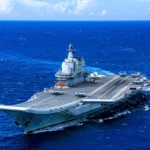The article explores China’s maritime strategy in the Indo-Pacific region, drawing on the theories of Alfred Mahan regarding sea power and the concept of island chains. It highlights how China’s expansionist activities, such as developing ports and controlling strategic chokepoints, align with Mahan’s emphasis on naval dominance.
The article also delves into the island chains theory, which China has adapted to enhance its influence in the Pacific. This adaptation has raised security concerns among neighboring countries. China’s actions are viewed as part of a broader geostrategic ambition in the region.
Read more below.
China in the Indo-Pacific: Alfred Mahan and the Island Chains
China is applying Mahan’s geopolitical theory to enhance its maritime dominance, notably through strategic port developments and asserting control over critical maritime chokepoints. It’s expanding influence across strategic island chains in the Pacific highlights its efforts to strengthen naval capabilities and economic leverage in the region.
Over the last decade, many international actors from across China’s immediate neighbourhood and far continents have become increasingly worried about Beijing’s growing power and assertiveness at sea. Analysing China’s current oceanic strategy, one argument is that certain aspects of China’s strategic movements reflect Alfred Mahan’s formal geopolitical theory about naval power as an enabler of global domination, albeit combined with the adaptation of the island chains practical geopolitical idea.
Mahan’s geopolitical theory suggested that the state’s global power is enabled by its naval strength and outreach. According to Mahan, the key elements defining the country’s sea power are geographical, physical, territorial, population, customary, and governmental. Geographically, it is vital to hold control over strategic chokepoints and trade hubs. One example of this is Beijing’s exclusive-use port system. Its port in Djibouti with large military facilities allows China to project power into the maritime chokepoint at the entrance to the Red Sea, while the deep-water brand-new Hambantota port in Sri Lanka is well-placed for developing a hub-and-spoke trade model. Mahan argues that large navigable harbours and waterways facilitate effective naval operations and, territorially, a country’s long, all-seasons-navigable coastal line matters more than a total land area. In this respect, China holds an advantage over, for instance, Russia, whose northern coastline is effectively locked in ice.
Additionally, China has envisioned extending its effective coastal presence into the Indian Ocean through the development of the ports Kyaukpyu in Myanmar and Gwadar in Pakistan (linked with the Chinese provinces of Yunnan and Xinjiang respectively to bypass the Malacca Strait for gas and oil and other commodities transportation and potential military use). In terms of population, which can potentially enhance naval infrastructure and strength, the only comparable to China is India, whose total coastal population are similar, although actual workforce differences are still significant. Unlike Mahan, who advocated for self-governance, democratic institutions, and strategic partnership of maritime republics, Beijing prefers an authoritarian modus operandi. Beijing seeks to dominate its smaller “partners” and to streamline naval development more effectively than liberal democracies.
Mahan’s geopolitical idea underscores the pivotal role of naval might in the rise and fall of world powers. Beijing’s twist of Mahan’s strategy, as with all Western concepts, is its addendum “with Chinese characteristics”; in other words through maritime “silk roads and string of pearls” or chain of ports and naval bases it has been building.
Another theme of practical geopolitics worth unpacking here is the island chains theory. The “island chain” term takes its roots in 1950s US strategic thought of practical containment of Soviet and Chinese communism in the West Pacific. However, the categorisation of islands into the “first” and subsequent chains originates in 1980s Chinese expansionist naval strategy. Today, the First island chain primarily refers to the islands at the eastern edge of the East and South China seas—from the Japanese archipelago in the north, southward through the Ryukyu and Taiwan islands, the Philippine archipelago, and down to the Greater Sunda island. Beijing’s aggressive oceanic stance, aiming to “reclaim” exclusive sovereign rights over vast maritime areas (with Taiwan in its spotlight) is comparable to Moscow’s invasive terrestrial ambitions over Eastern Europe.
The Second island chain is another island ring from Japan that expands via Guam and Palau to the West Papua of Indonesia, while the Third stretches from the Aleutian Islands near Alaska through the Hawaiian Islands down via Tonga to New Zealand. The number of Chinese ships now operating within all three island chains has significantly increased; many are often dual-use military-civilian vessels. Moreover, their behaviour has become increasingly aggressive and intimidating to those under flags of weaker states—and constitutes a security threat in the Pacific.
China’s armed and military forces might be welcome on soil as close to the Third island chain as the Solomon Islands according to the leaked draft of the 2022 Security Agreement and the comments from the US Department of Defense, and there is a growing worry about the establishment of another multi-purpose Chinese port there. Moreover, considering economic dependency on China, there have been concerns about New Zealand being too susceptible to Chinese “Finlandization”—a policy akin to Soviet coercion of Finland into neutrality during the Cold War—which, because of its administration over Niue, Tokelau, and Cook Islands, constitutes a risk for fragmentation of the Pacific line of defence. While the geopolitical concept of island chains in the Pacific Ocean is more vivid when one looks at the map, it is still married with Mahan’s theory in China’s expansionist geostrategy of seeking to obtain privileged access to, and develop exclusive-use facilities at, crucial maritime points in the Pacific.
The island chains are lines on geographical maps, representing imaginary water space edges, and thus can be applied not only to islands in the Pacific but also to land contours in the Indian Ocean. Since Myanmar has plunged into civil war, China has managed to simultaneously support the new junta regime and constructively engage with the ethnic groups who have taken control over the country’s mutual border and initially disrupted their trade links. Assuming it can complete the recently revived Kyaukphyu Port project and restore an overland pathway, Beijing will gain a large harbour on the Indian Ocean coastline. Thus, another, the fourth, island chain for China can be drawn from the Pakistani port of Gwadar through the Sri Lankan Hambantota Port southward, passing the Diego Garcia US military base in British Indian Ocean Territory, while China’s controlled ports on the western edge of the Indian Ocean will constitute the fifth.
China’s oceanic geostrategy across the last couple of decades resembles a mixture of Mahan’s formal geopolitical theory about sea power and the more practically constructed geopolitical idea of the island chains as concentric rings of privileged influence emanating from the mainland throughout the Indo-Pacific. Theorising these trends is always difficult, but should they continue, New Zealand might need to consider the terrestrial lessons from Eastern Europe and following the lead of Finland—which joined the NATO in reaction to Moscow’s renewed military invasion of Europe—in the Pacific, particularly in joining AUKUS.
By: Kyrylo Cyril Kutcher – a Master of Science with a fifteen-years transnational career, who used to live in Eastern Europe before immigrating to New Zealand. He is currently a last-year student of the Politics and International Relations in the Massey University of Auckland.







